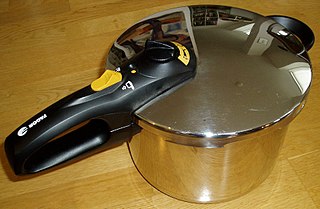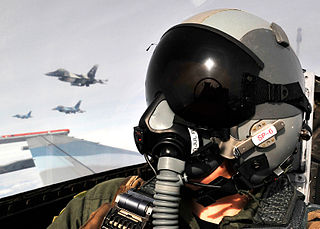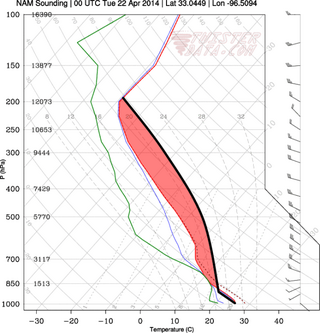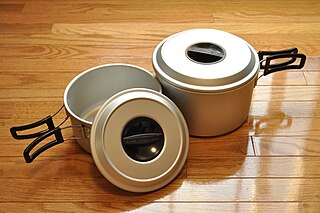
The boiling point of a substance is the temperature at which the vapor pressure of a liquid equals the pressure surrounding the liquid and the liquid changes into a vapor.
Atmospheric pressure, also known as air pressure or barometric pressure, is the pressure within the atmosphere of Earth. The standard atmosphere is a unit of pressure defined as 101,325 Pa (1,013.25 hPa), which is equivalent to 1,013.25 millibars, 760 mm Hg, 29.9212 inches Hg, or 14.696 psi. The atm unit is roughly equivalent to the mean sea-level atmospheric pressure on Earth; that is, the Earth's atmospheric pressure at sea level is approximately 1 atm.

A barometer is a scientific instrument that is used to measure air pressure in a certain environment. Pressure tendency can forecast short term changes in the weather. Many measurements of air pressure are used within surface weather analysis to help find surface troughs, pressure systems and frontal boundaries.

Boiling or ebullition is the rapid phase transition from liquid to gas or vapor; the reverse of boiling is condensation. Boiling occurs when a liquid is heated to its boiling point, so that the vapour pressure of the liquid is equal to the pressure exerted on the liquid by the surrounding atmosphere. Boiling and evaporation are the two main forms of liquid vapourization.

Pressure cooking is the process of cooking food under high pressure steam and water or a water-based cooking liquid, in a sealed vessel known as a pressure cooker. High pressure limits boiling and creates higher cooking temperatures which cook food far more quickly than at normal pressure.
Altitude is a distance measurement, usually in the vertical or "up" direction, between a reference datum and a point or object. The exact definition and reference datum varies according to the context. Although the term altitude is commonly used to mean the height above sea level of a location, in geography the term elevation is often preferred for this usage.

The atmosphere of Earth is the layer of gases, known collectively as air, retained by Earth's gravity that surrounds the planet and forms its planetary atmosphere. The atmosphere of Earth creates pressure, absorbs most meteoroids and ultraviolet solar radiation, warms the surface through heat retention, and reduces temperature extremes between day and night, maintaining conditions allowing life and liquid water to exist on the Earth's surface.

A cloud base is the lowest altitude of the visible portion of a cloud. It is traditionally expressed either in metres or feet above mean sea level or above a planetary surface, or as the pressure level corresponding to this altitude in hectopascals.

A slow cooker, also known as a crock-pot, is a countertop electrical cooking appliance used to simmer at a lower temperature than other cooking methods, such as baking, boiling, and frying. This facilitates unattended cooking for many hours of dishes that would otherwise be boiled: pot roast, soups, stews and other dishes.

The density altitude is the altitude relative to standard atmospheric conditions at which the air density would be equal to the indicated air density at the place of observation. In other words, the density altitude is the air density given as a height above mean sea level. The density altitude can also be considered to be the pressure altitude adjusted for a non-standard temperature.

Sous vide, also known as low-temperature, long-time (LTLT) cooking, is a method of cooking invented by the French chef Georges Pralus in 1974, in which food is placed in a plastic pouch or a glass jar and cooked in a water bath for longer than usual cooking times at a precisely regulated temperature.

The Armstrong limit or Armstrong's line is a measure of altitude above which atmospheric pressure is sufficiently low that water boils at the normal temperature of the human body. Exposure to pressure below this limit results in a rapid loss of consciousness, followed by a series of changes to cardiovascular and neurological functions, and eventually death, unless pressure is restored within 60–90 seconds. On Earth, the limit is around 18–19 km above sea level, above which atmospheric air pressure drops below 0.0618 atm. The U.S. Standard Atmospheric model sets the Armstrong pressure at an altitude of 63,000 feet (19,202 m).

In meteorology, convective instability or stability of an air mass refers to its ability to resist vertical motion. A stable atmosphere makes vertical movement difficult, and small vertical disturbances dampen out and disappear. In an unstable atmosphere, vertical air movements tend to become larger, resulting in turbulent airflow and convective activity. Instability can lead to significant turbulence, extensive vertical clouds, and severe weather such as thunderstorms.
The vapor pressure of water is the pressure exerted by molecules of water vapor in gaseous form. The saturation vapor pressure is the pressure at which water vapor is in thermodynamic equilibrium with its condensed state. At pressures higher than vapor pressure, water would condense, while at lower pressures it would evaporate or sublimate. The saturation vapor pressure of water increases with increasing temperature and can be determined with the Clausius–Clapeyron relation. The boiling point of water is the temperature at which the saturated vapor pressure equals the ambient pressure.

The effects of high altitude on humans are mostly the consequences of reduced partial pressure of oxygen in the atmosphere. The medical problems that are direct consequence of high altitude are caused by the low inspired partial pressure of oxygen, which is caused by the reduced atmospheric pressure, and the constant gas fraction of oxygen in atmospheric air over the range in which humans can survive. The other major effect of altitude is due to lower ambient temperature.

Cooker may refer to several types of cooking appliances and devices used for cooking foods.

A thermal cooker, or a vacuum flask cooker, is a cooking device that uses thermal insulation to retain heat and cook food without the continuous use of fuel or other heat source. It is a modern implementation of a haybox, which uses hay or straw to insulate a cooking pot.

A multicooker is an electric kitchen appliance for automated cooking using a timer. A typical multicooker is able to boil, simmer, bake, fry, deep fry, grill roast, stew, steam and brown food.
Height above mean sea level is a measure of the vertical distance of a location in reference to a historic mean sea level taken as a vertical datum. In geodesy, it is formalized as orthometric heights.













